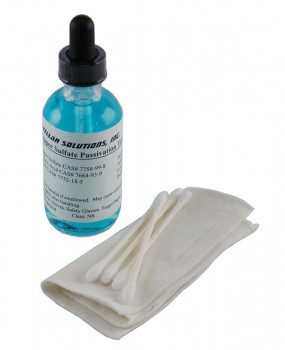Copper Sulfate Passivation Test Kit
Technical Data:
Description:
The copper sulfate test is intended to verify the effectiveness of the stainless steel passivation treatment. It can also be used to determine if there is a need for passivation.
The purpose of the copper sulfate test is to determine the presence of free iron which is often transferred onto the surface of a part during fabrication with steel components. The principle of the copper passivation test is based on an oxidation-reduction reaction which causes the dissolved copper ions to deposit or plate out onto the locations of free iron particles.
This passivation tester is recommended for the detection of free iron on the surface of austenitic stainless steels in the 200 and 300 series, precipitation hardened stainless steels, and ferritic 400 series stainless steels having a minimum of 16 % chromium. This test is not recommended for martensitic 400 series stainless steels or for ferritic 400 series stainless steels with less than 16 % chromium because these steels will typically give a positive indication irrespective of the presence or absence of anodic surface contaminants (a “false failure”). This test is also not recommended for laser marked areas.
![[PDF] Download this page](http://citrisurf.com/wp-content/uploads/2018/04/PDFdownloadpage.gif)
Physical Properties:
| Form | Liquid |
| Chemical Composition | Water, copper sulfate, sulfuric acid |
| Operating Temperature | Room temp |
Packaging:
2 oz dropper bottle. Contains sufficient solution for hundreds of tests.
Application Procedure:
 The test solution is applied to the surface of the sample(s) representing the lot of passivated parts, applying additional solution if needed to keep the surface wet for a period of at least 6 minutes. At the end of this period, the surface shall be carefully rinsed and dried with care taken not to disturb copper deposits if present. The test sample shall not exhibit copper deposits visible to the naked eye.
The test solution is applied to the surface of the sample(s) representing the lot of passivated parts, applying additional solution if needed to keep the surface wet for a period of at least 6 minutes. At the end of this period, the surface shall be carefully rinsed and dried with care taken not to disturb copper deposits if present. The test sample shall not exhibit copper deposits visible to the naked eye.
A copper color on the metal surface (brown or pinkish, like a penny) indicates that surface iron was still present and is considered a test failure. If no reaction occurs it is considered a test pass.
Notes on Use:
For best results, allow a few hours after passivation before testing.
This test is generally used as a per-lot acceptance test after passivation treatment. It is not implied nor should it be inferred that stainless steel parts prior to a passivation treatment should or necessarily will display a fail condition with this test.
A failure state can be readily observed, and the solution confirmed as functional, by using the copper sulfate solution on a piece of clean carbon steel.
Technical Services:
For technical assistance, please contact Stellar Solutions at (847) 854-2800.
Standards:
When used correctly, the copper sulfate test meets the requirements of the ASTM A967, ASTM A380, ASTM B912, ASTM F1089, and AMS 2700, and MIL-STD-753 standards.
Other standards and test methods that make use of a copper sulfate solution may involve a different concentration, and may not function properly with the specific composition used for this test solution.
No warranty is implied, or may be given in writing or verbally without the written permission of Stellar Solutions, Inc.

